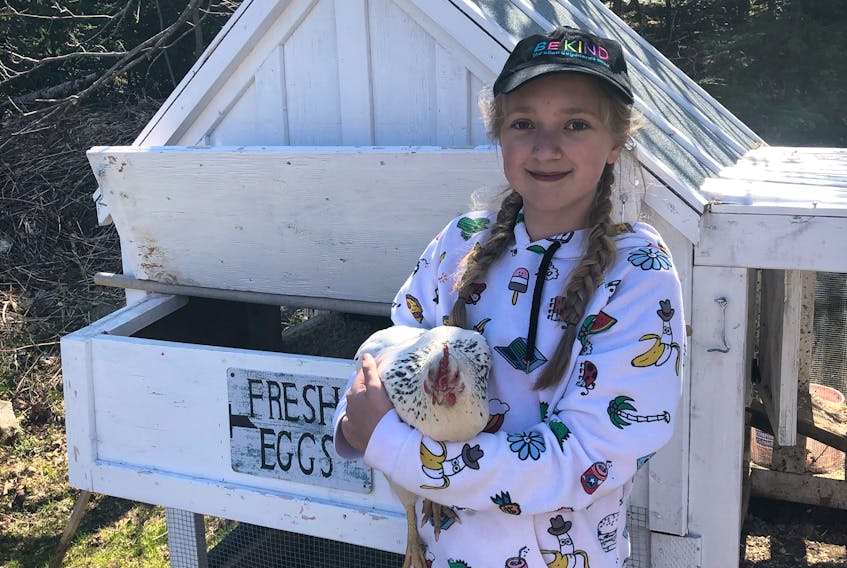Raising chickens has become one of the hottest trends during COVID-19.
Chickens are hearty animals, make great pets and, says Port Williams, N.S. resident Barb Baker, they have wonderful personalities as well.
Melanie Sora from Hebbs Cross, N.S., says there has been a recent surge in membership to the Facebook Group she helps administrate, Poultry Atlantic Canada. Sora – who blogs about her chickens at the The Mother Cluckin' Road Trip Across Canada Facebook page. - says people who breed heritage birds are busy with the demand for hatching eggs, chicks and pullets (a young hen who has yet to lay eggs) this year.

“People assume it takes a lot of time to take care for chickens and therefore think this is a convenient opportunity for putting the time into it,” says Darren LeBlanc from New Perth, P.E.I., who started raising chickens two years ago.
Also, people may be thinking about food insecurity, or the farm-to-table element of growing and raising their own food, he adds.
Linda Pattison, also an administrator for the Poultry Atlantic Facebook page, urges people to hold off from getting chickens on a whim until they fully understand what is involved, including feed costs, good construction and proper management.
What it takes
The first step is to have a proper and safe place to keep your chickens. LeBlanc says a coop should be a sheltered area with at least two square feet of space per chicken.
In fact, chicken owner Joanne MacMaster, from Porters Lake, N.S., suggests building a coop double the size required for whatever amount of chickens you think you will get. Coops should also have easy access to the nesting box for cleaning and removing eggs. The coop enclosure should also be a good size, as chickens need lots of room to scratch and dust bathe, she says.
Linda MacKay, from Brackley, P.E.I., adds that chickens need an opening and a walkway to get in and out of their coop.
“If they are too crowded, they will peck and bother each other,” says MacMaster.
MacKay says the enclosure should be surrounded by heavy wire (two- by four-inch squared), and it’s very important that it is dug underground so predators can’t get in. And look up – if predators like bald eagles fly overhead, wire above the enclosure as well, she says.
MacMaster also suggests wrapping coops in plastic during the winter months, as it cuts down on shovelling and gives "the girls" protection from wind and rain.
As for feed, chickens require fresh water every day – remember, it freezes in the winter. Baker says she’s careful to wash the water dispenser every day and adds some apple cider vinegar to the water to avoid a common bacterial infection.
A bag of layer feed is $25 and lasts more than two months for nine birds, says Baker. For her, the cost of having chickens works out to about $1.25 for a dozen fresh free-range eggs.

MacMaster says upkeep is minimal, and like any other caged animal, they only smell if you don't clean them. You need a bale of straw, which is about $7, and a bag of shaving, about $6, and lasts for about a month or two.
“I probably spend 30 to 60 minutes a month in cleaning, a bit more during the winter months when they are inside more,” says MacMaster.
Baker uses what’s called the deep-litter method, meaning the chickens have a deep bed of litter that isn’t completely removed. Every 10 days or so, she cleans out the areas below their roosts and adds some fresh peat moss and new straw in the nest boxes.
To hatch or not to hatch
Pattison says hatching chicks is a mistake for beginners, as half will be roosters, and not every egg is a good or safe egg. You need skills that take time to develop and mentorship to get there, she says.
Brooding - the raising of young chicks - is also quite difficult for the beginner, says LeBlanc, as it requires constant monitoring of the young chicks to ensure they are being kept at an appropriate temperature. Heat lamps are difficult things to master, he says.
Trevor MacDonald has been raising purebred poultry in P.E.I. since 1978. Depending on where you are keeping the birds, he says, will determine the type of heat source you need. In a house, a 60-watt light bulb can be adequate. In a cooler location, a heat lamp bulb may be needed.
When it comes to determining what type of chickens to get, first decide if you want layers or meat birds, and what your intentions are for the birds.
“The layers are so frisky and fun, but the meat birds are so heavy, they only get up to eat,” says Baker. “Layers have wonderful personalities, but meat birds are just lumps.”
Meat birds, she says, are processed around four to six weeks, so the layers make the best pets.
Jaime Snow-Parsons, from Goulds, N.L., researched different breeds that would be good with children and also good layers, asking a local breeder for advice.
Every town has different rules about having backyard chickens, especially roosters, so it’s also important to research that first.
“We chose not to have (a rooster) as they tend to crow throughout the day and sometimes night,” says MacMaster. “We didn't want to hear it or bother our neighbours. If we had a bigger property, we would look at getting one, as they are good protection for the flock.”

Other benefits
In addition to the eggs, Snow-Parsons wanted chickens for the gardening benefits, like the manure and eating bugs in her garden, and as pets for her 11-year-old daughter, who learned about chicken farming through 4-H.
Chickens make a great start in backyard homesteading, and MacMaster says not only do they provide entertainment, it’s also an educational experience for her kids as well.
If you are serious about getting started with chickens, MacDonald says it is important to talk to those who have had poultry for a period of time. He recommends joining Facebook groups like Poultry Atlantic Canada or Maritime Fowl, where you can ask questions and get answers from reputable sources.
Crazy chicken stories
Ask any chicken owner and they likely have a great chicken-related story to share.
Barb Baker had one of her brood go missing without a trace.
Almost three weeks later, Baker noticed some feathers sticking out from around the bottom of an upside-down basket, and when she turned it over, there was her missing chicken.
“She must have been sitting on the side of the basket looking for a treat and it flipped over on top of her. We are in and out of that room several times a day, but she never made a peep,” says Baker.
“She was in surprisingly good shape and must have eaten her own eggs, and then her own droppings, to stay alive.”
After a period of self-isolation, Baker re-introduced her to the flock, and she went on to live another few years.

Joanne MacMaster has a movie-famous chicken named Audrey Peckburn.
“We had just built our coop and were having a hard time finding chickens to put in it, so my husband advertised on Kijiji, along with a photo of our daughters sadly sitting in the empty coop. Before long, an animal handler for the Beethoven movie contacted us that she had a chicken retiring from the movie business, and would we take her?”
Months before, the handler had picked up a meat king pullet to train for a bit part in the movie. The chicken was named BBQ and was trained to walk a railing, coming out when called.
Once they did the scene, BBQ was sent back to the farm she came from to be processed. The director decided he wanted to do a couple more scenes with her, but she was due to be processed the next day. How would they pick out BBQ from the sea of white chickens?
“The trainer told the farmer, no worries, just tap a tin can with a spoon and she'll come to you. He thought she was crazy but tried anyway. As soon as he started tapping, a little white head popped up and she pushed her way through all the other pullets to sit at his feet waiting expectantly for her treat,” MacMaster said.
“He scooped her up and she went on to continue her movie star career. Once the filming was done, her handler did not have the heart to send her back to the farm and contacted us. Of course, we'd take a movie star chicken! She even had her very own bowtie that she wore in a few scenes.”
MacMaster said she was a very sweet bird, following her around like a dog, and was very food-oriented.










